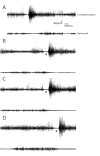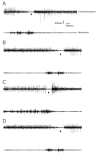Successful Treatment of Post COVID-19 Neurogenic Dysphagia with Botulinum Toxin
- PMID: 38077706
- PMCID: PMC10705822
- DOI: 10.12890/2023_004105
Successful Treatment of Post COVID-19 Neurogenic Dysphagia with Botulinum Toxin
Abstract
Introduction: Dysphagia in post COVID-19 patients could be caused by several factors, including reduced pharyngolaryngeal coordination due to SARS-CoV-2 tropism to the central and/or peripheral nervous system. To our knowledge, this is the first reported case of COVID-19-related dysphagia successfully treated with botulinum toxin type A injection.
Case description: We report the case of a patient with severe oropharyngeal dysphagia due to COVID-19 confirmed by fibre endoscopy. As a result, the patient required an enteral feeding tube. After two months of traditional swallowing therapies, there was only limited improvement. An electrophysiologic evaluation of the cricopharyngeal muscle was performed and showed a normal inhibition of the cricopharyngeal muscle, followed by a hypertonic rebound. Based on this result, we decided to perform a unilateral laryngeal injection of botulinum toxin type A. After the injection, the patient's swallowing function improved significantly, allowing him to return to oral feeding.
Discussion: Newly diagnosed oropharyngeal dysphagia was found in 35.3% of hospitalised patients with COVID-19. There are several possible causes of COVID-19-associated dysphagia, including stroke, encephalitis, critical illness neuropathy, Guillain-Barré syndrome and skeletal muscle injury. In our case, since stroke was excluded by brain MRI, cranial nerve injury was a possible explanation for the difficult recovery of swallowing despite daily swallowing therapy.
Conclusion: We suggest that electrophysiology is a valid tool for the diagnosis and follow-up of patients with oropharyngeal dysphagia.
Learning points: SARS-CoV-2 tropism to the central and/or peripheral nervous system can cause dysphagia in post COVID-19 patients.An electrophysiologic approach is useful for the diagnosis and follow-up of patients with oropharyngeal dysphagia.A single botulinum toxin type A injection is a valid treatment option to improve the swallowing function in patients with post COVID-19 dysphagia.
Keywords: COVID-19; EMG; botulinum toxin; dysphagia.
© EFIM 2023.
Conflict of interest statement
Conflicts of Interests: The Authors declare that there are no competing interests.
Figures





References
-
- Vergara J, Skoretz SA, Brodsky MB, Miles A, Langmore SE, Wallace S, et al. Assessment, diagnosis, and treatment of dysphagia in patients infected with SARS-CoV-2: a review of the literature and international guidelines. Am J Speech Lang Pathol. 2020;29:2242–2253. - PubMed
LinkOut - more resources
Full Text Sources
Research Materials
Miscellaneous
